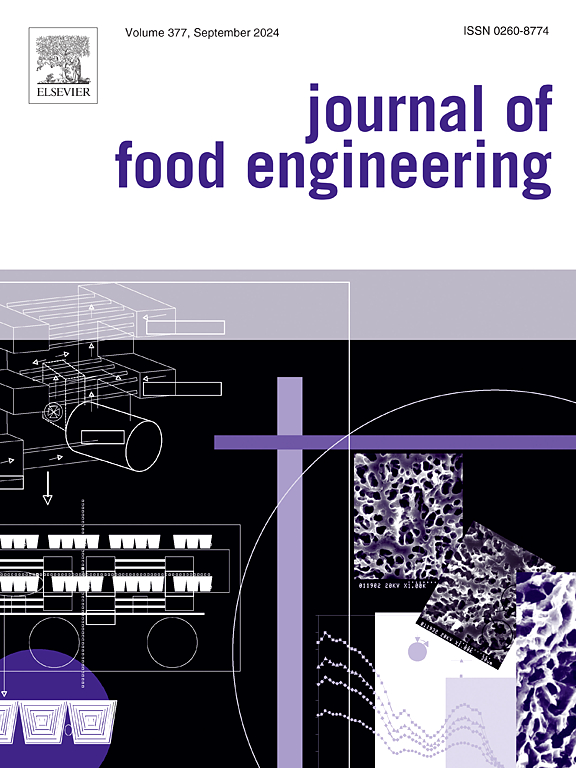基于转换效率因子测量脉冲光处理总通量的新方法
IF 5.3
2区 农林科学
Q1 ENGINEERING, CHEMICAL
引用次数: 0
摘要
这项工作提出了一种间接的方法来估计脉冲光(PL)处理期间的辐射暴露(He = Qlight/A)或影响,通过观察培养皿中冰的融化速度和PL室内金属托盘的温度升高。我们提出,由于PL处理而产生的任何变化(物理/化学/微生物)都是He的函数,因此可以使用Pratap-Singh-Ramaswamy (PSR)转换效率因子与He相关。这一假设在PL处理过程中涉及热交换的两种处理中得到了检验:a)冰的融化(由于潜热)和b)样品温度的升高(由于感热)。收集的数据显示,在特定位置测量的热交换参数(接收的热能Qh,冰融化的小鼠,温度上升Trise)与入射辐射通量(He)之间存在很强的相关性,从而验证了假设。采用一阶模型拟合不同过程的PSR因子,其中PSRthermal、PSRlatent和PSRsensible分别作为Qh、mice、Trise v/s He曲线的斜率,对应的系统配置项(δh、δi和δT)作为截距。冰融化潜热方法的PSRthermal值几乎是前者的2-3倍,表明它是采用该方法的较好候选。所提出的方法在He计算值和实际He值之间得到了很好的拟合。利用不同微生物(大肠杆菌K12、嗜脂嗜热杆菌G.、产孢杆菌C.)的PL破坏动力学数据验证了这一概念,分别为0.3212、0.2395 cm2/J和0.0925 cm2/J。总之,本研究为一种简单、快速、经济的估算吸收脉冲光能量的技术奠定了基础。本文章由计算机程序翻译,如有差异,请以英文原文为准。
A new methodology to measure total fluence during pulsed light treatment based on a conversion efficiency factor
This work presents an indirect approach for estimating the radiant exposure (He = Qlight/A), or fluence, during pulsed light (PL) treatment by observing the rate of melting of ice in a petridish and temperature increase in a metal tray kept inside the PL chamber. It was proposed that any change (physical/chemical/microbiological) produced due to PL treatment is a function of He and thus can be correlated to He using Pratap-Singh-Ramaswamy (PSR) conversion efficiency factor. This hypothesis was tested for two treatments that involved heat exchanges during PL treatment: a) melting of ice (due to latent heat) and b) rise of sample temperature (due to sensible heat). Gathered data showed a strong correlation between the measured heat exchange parameters (thermal energy received Qh, ice melted mice, temperature rise Trise) and the incident radiant flux (He) at a particular location, thus validating the hypothesis. The PSR factor for different processes were fitted using a first-order model, wherein PSRthermal, PSRlatent and PSRsensible were evaluated as the slope of Qh, mice, Trise v/s He curves, respectively, and corresponding system configuration terms (δh, δi and δT) were evaluated as intercepts. The value of PSRthermal was almost 2–3 folds better for the ice melting latent heat method, suggesting it to be a better candidate for adopting this methodology. The proposed methodology gave a good fit between the calculated and actual He values. The concept was also validated using data for PL destruction kinetics for different microbes (E coli K12, G. stearothermophilus, C. sporogenes) were established as 0.3212, 0.2395 cm2/J and 0.0925 cm2/J. Overall, this study lays the foundation of a simple, rapid and cost-effective technique to estimate the absorbed pulsed light fluence.
求助全文
通过发布文献求助,成功后即可免费获取论文全文。
去求助
来源期刊

Journal of Food Engineering
工程技术-工程:化工
CiteScore
11.80
自引率
5.50%
发文量
275
审稿时长
24 days
期刊介绍:
The journal publishes original research and review papers on any subject at the interface between food and engineering, particularly those of relevance to industry, including:
Engineering properties of foods, food physics and physical chemistry; processing, measurement, control, packaging, storage and distribution; engineering aspects of the design and production of novel foods and of food service and catering; design and operation of food processes, plant and equipment; economics of food engineering, including the economics of alternative processes.
Accounts of food engineering achievements are of particular value.
 求助内容:
求助内容: 应助结果提醒方式:
应助结果提醒方式:


